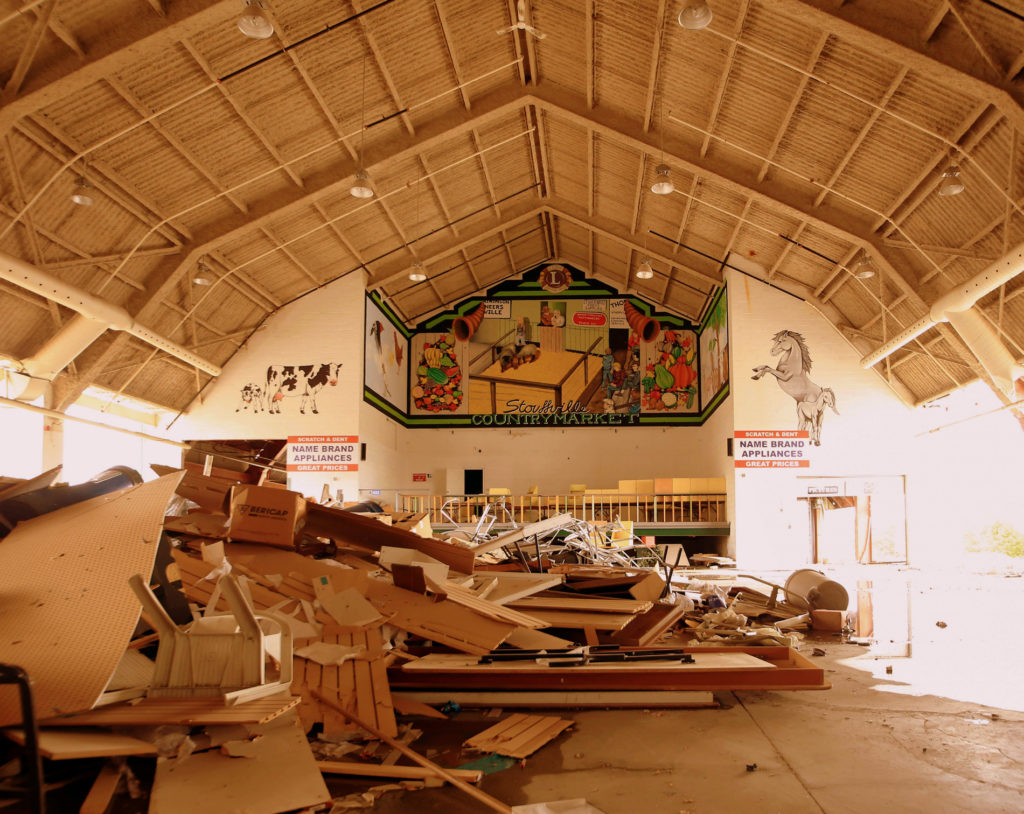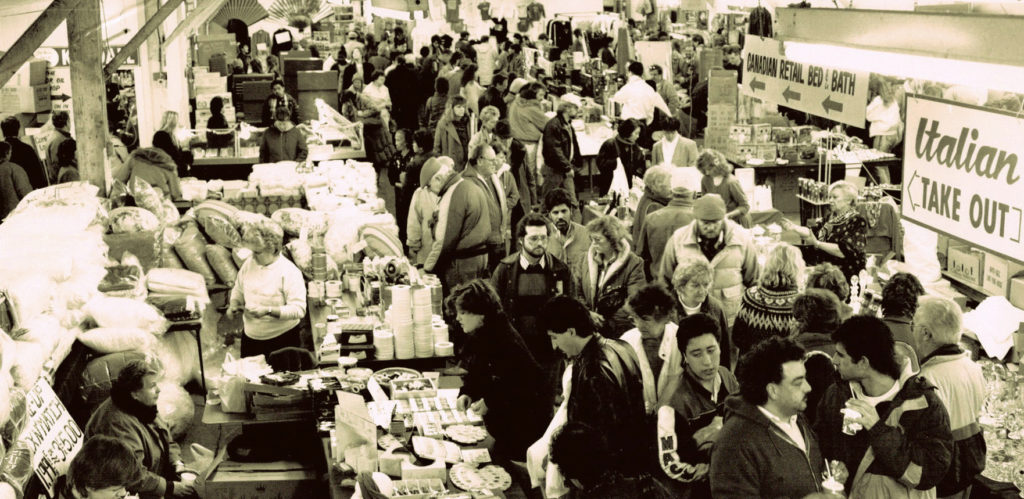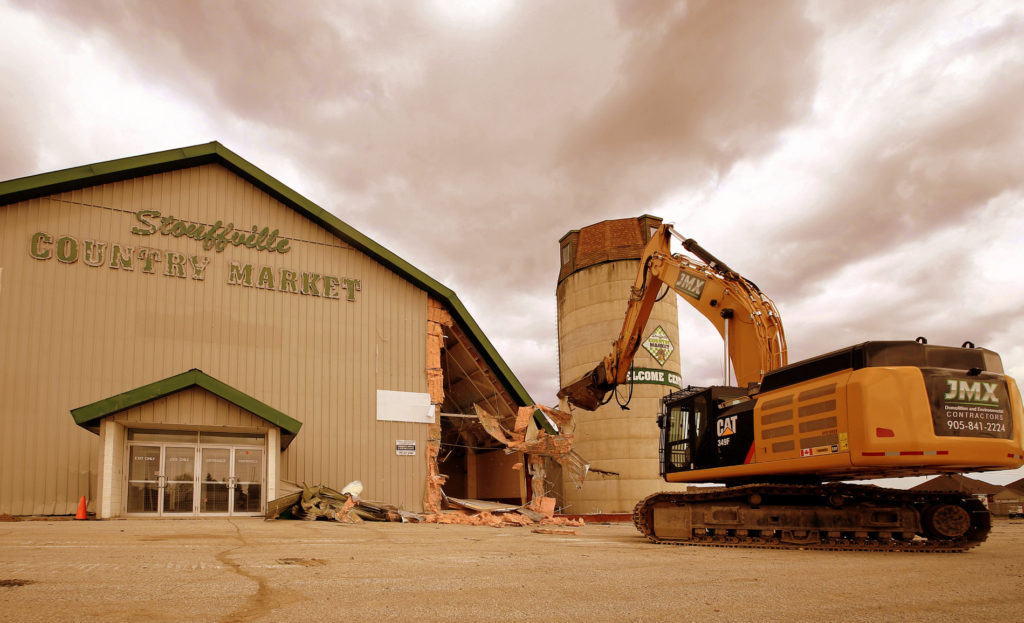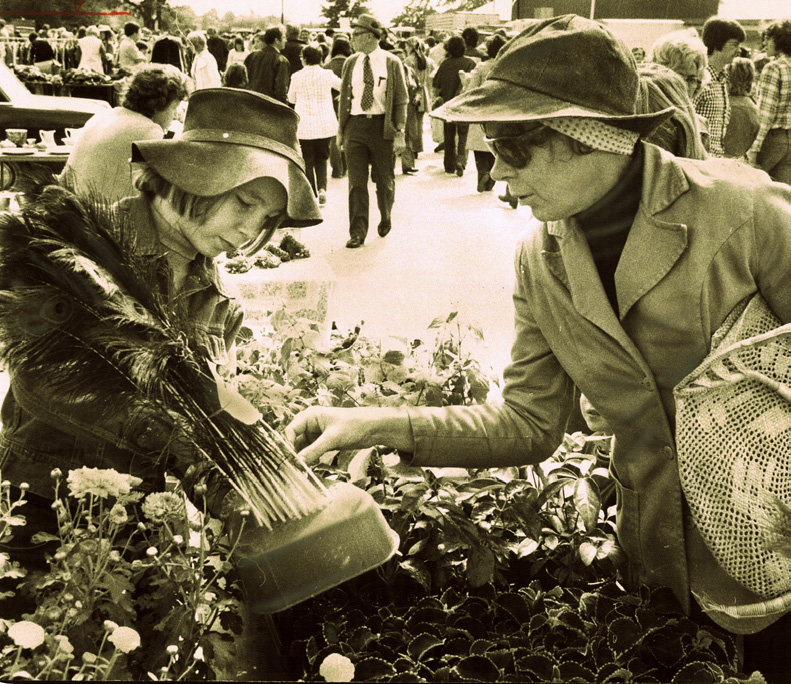It was a perfect storm as an attraction – a bargain hunt, country charm and great variety. Very few old barns in Ontario were capable of drawing 20,000 visitors on a Saturday from great distances away. They descended upon the community in droves, clogged the main street, put Stouffville on the map and became imprinted on the routines and identity of two generations.
It was planned as the Stouffville Sales Arena, but opened as the Stouffville Stockyards and Farmer’s Market. The focus changed with the times, from stockyard to flea market, and so did its name: Stouffville Sales Barn, Stouffville Flea Market, Stouffville Country Flea Market, and finally Stouffville Country Market. Informally, it had been known as The Big Flea and The Sales Barn. (Referred to as “The Market” herein).
“It was a perfect storm as an attraction – a bargain hunt, country charm and great variety.”
The Market closed its doors last year to make way for new residential development. It is currently being demolished, and ironically, by Charlie Dahl of JMX Contracting. We interviewed Charlie, a local resident, in On the Road last fall when he was demolishing the Southwire plant on Mostar. Charlie was the Regional Manager with QM Environmental back then, but now he is the VP of this Whitchurch-Stouffville company located on Ram Forrest Road.
The irony is – “I am here because while on one of my weekend visits to the Flea Market I saw a house for sale. I bought it and moved to Stouffville. That was many years ago,” says Charlie. The demolition process is scheduled to take three months, start to finish. Most of the materials are being recycled on site. As usual, Charlie has great sensitivity for the surrounding neighbours when doing a job like this. He says that “minimizing impact is key”.
The Market opened in 1952 as a livestock auction. With each year its offerings were expanded, beginning with baked goods and vegetables, and then a restaurant. Later, everything was available: antiques, auto parts, name-brand clothing, stereos, books, paintings, aquarium supplies, axe handles, sporting goods, pets, china dolls and kitchenware.
There were as many as 700 vendors on occasion, but usually 300-500 vendors would descend on the site in the early hours of Saturday morning.
Walter Atkinson, a prominent Stouffville auctioneer, built The Market from the ground up from scavenged barn wood in northeast Stouffville. Its permanent location came to be along Highway 47, now known as Tenth Line. In the early 1960s, Atkinson sold his interests in The Market to auctioneers Norm Faulkner (childhood friend of Eldred King) and Frank Bennett. Norm Clements, the owner of the prominent retail chain National Sports, bought out Bennet’s share in 1984.
“Headlines like ‘Stouffville’s dirty little secret’ didn’t bode well for the Market. This hasn’t been the only controversy.”
As a sideline, Faulkner and Clements became known as the “Two Norms”, not because of The Market, but rather in the horse racing industry. They owned a lucky horse – Cam Fella – the richest Standardbred horse of all-time. A Stouffville street is named Cam Fella Boulevard in the horse’s honour. Faulkner later sold his interests in The Market to Clements in 1990. Atkinson died in 1992 at the age of 88, Faulkner in 1996 at 60.
The Market’s reputation became tarnished over the last decade, as animal rights activists turned attention to the sale of live animals – ducks, chickens, rabbits, pigeons. The traditional way of selling live animals and sacking them like groceries did not rest well with everyone. Local farmers, in contrast, argued that this practice embraced new traditions too, such as the farm-to-fork movement; one knows where their food comes from when it is bought live, as opposed to deboned and plastic wrapped from a factory farm. The argument boils down to a wavering line of opinion on animal cruelty.
The live animal issue also haunted the Market back in 1982. Multiple regulatory bodies weighed in on the subject, but their determinations were equally mired in moveable interpretation. Either way, headlines like “Stouffville’s dirty little secret” didn’t bode well for the Market. This hasn’t been the only controversy.
In the late 1980s, York Regional Police laid charges against many stores under the Retail Business Holidays Act, including Hy & Zels, Shoppers Drug Mart, and The Market, for illegally operating on Sundays.
In 1987, a toy stall vendor was arrested in possession of $27,000 worth of stolen model cars, games and hobby crafts. In the early 1990s, many flea markets – including The Market – were raided by the police on behalf of the National Basketball Association for un-licensed use of team logos and colours; products were seized. Finally, there were decades of politically-sensitive debates involving blowing garbage, overrun septic systems, fire hazards and traffic congestion.
“The Market was constantly reinvented in an effort to maintain public interest.”
On the flipside, a myriad of magazine and newspaper articles have identified the famous Stouffville market as a place to: take a break with the family and enjoy pony rides; as a perk-reason to buy a local home; as a place that brought people together or unexpectedly reunited folks that had been disconnected; and as a place where retail proprietors got a head start in business.
The building that is being demolished now, or the “Stouffville Country Market”, was built in 1993-94 in an effort to keep the market from becoming stale. The structure allowed for more vendors to operate from an indoor setting during the winter months, and a place for groups like the Chamber of Commerce to hold their annual home show.
The Market was constantly reinvented in an effort to maintain public interest. In the 1990s they tried weekly concerts, garden shows, and bingo, but the customer count continued to decline. Popular opinion described the place as “a shadow of its former self” – downsized, old, expired. At one point The Market announced its impending closure in 2007; it didn’t happen then, but the announcement of closure in 2016 did close the chapter on an impactful part of Stouffville’s history.
Left and bottom left – demolition underway (photos by J. Williams). Above – packed with shoppers in 1989, and Below right – peacock feather shopping in 1975 (TorStar Photo Archive)



